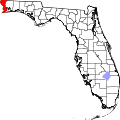Cantonment, Florida | |
|---|---|
| Coordinates: 30°36′30.7″N87°20′23.91″W / 30.608528°N 87.3399750°W [1] | |
| Country | United States |
| State | Florida |
| County | Escambia |
| Elevation | 148 ft (45 m) |
| Time zone | UTC-6 (CST) |
| • Summer (DST) | UTC-5 (CDT) |
| ZIP Code | 32533 |
| Area code | 850 |
| FIPS code | 12-10225 [1] |
| GNIS ID | 279994 [1] |
Cantonment is an unincorporated community in Escambia County, Florida, United States. [1] It is located north of Pensacola, south of Molino, and centered around Highway 29, and extends to the Perdido River to the west, and the Escambia River to the east.


